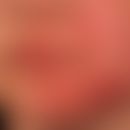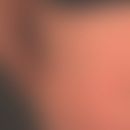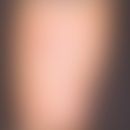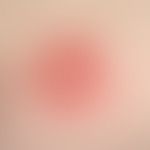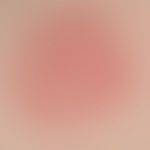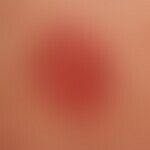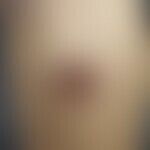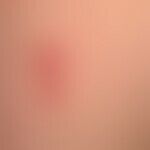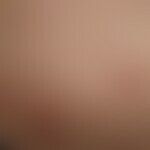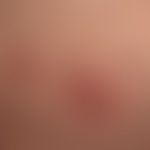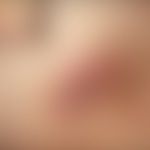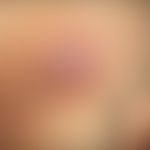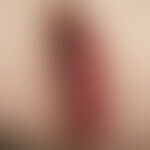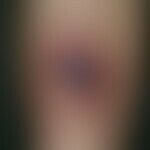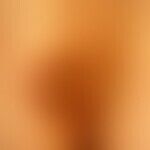Synonym(s)
HistoryThis section has been translated automatically.
Bourns in 1899; Brocq in 1894;
DefinitionThis section has been translated automatically.
Localized, patchy or plaque-like, also bullous or exfoliative drug reaction,
- which occurs in a temporal connection with the intake of drugs (see table for triggering drugs - >200 responsible drugs have been named in case reports since the beginning of this century) in therapeutic doses
- is limited to a solitary focus or to a few foci
- tends to recur in situ (recurrence in loco).
Fixed drug eruption (FDE) can be solitary, scattered or generalized; the majority of patients have five or fewer lesions (Pai V et al. 2014). The interval between drug exposure and the onset of FDE can be up to 2 weeks, but in most patients, especially those with previous drug exposure, the reaction occurs within 48 hours. At the time of presentation, most patients state that similar lesions have occurred in the past. With each recurrence, the lesions typically appear in the same locations as previous outbreaks. With repeated exposure to the causative drug, the disease can spread multilocularly to other sites that were not previously affected.
Local symptoms such as itching and/or burning associated with the outbreak occur in about a quarter of patients.
You might also be interested in
EtiopathogenesisThis section has been translated automatically.
The immunopathogenetic mechanism of the fixed drug reaction has not yet been clarified (see also Erythema multiforme). CD8+ memory T cells, which are located in the basal layer of the epidermis of dormant FDE lesions, play an important pathogenetic role. CD8+ positive cells persist for years in old, already clinically healed lesions (tissue-resident memory T cells) and can be expressed and activated on keratinocytes after re-exposure to the agent via a probably TNF-alpha-induced upregulation of ICAM-1 (see below adhesion molecules) (see also UV reactivation reaction). Within 24 hours after ingestion of a causative drug, these CD8+ T cells migrate upwards in the epidermis, produce cytokines such as interferon-gamma and TNF-alpha and take on the phenotype of natural killer cells that express the cell surface molecule CD56 as well as the cytotoxic molecules granzyme B and perforin. This activity leads to the epidermal necrosis observed in FDE. At the same time, CD4+ Foxp3+ regulatory T cells migrate into the epidermis and attenuate the damage caused by the CD8+ T cells. The action of the CD4+ regulatory T cells, which includes the production of the anti-inflammatory cytokine IL-10, explains the self-limiting nature of the "fixed drug reaction". After the acute phase of FDE has subsided, CD8+cells lose the natural killer phenotype they had acquired during an acute onset of FDE, and they remain dormant in the basal layer of the epidermis at the site of the previous onset for many years (Mizukawa Y et al. 2008).
Genetics: FDEs to the same drug have also been reported in immediate family members, suggesting that a genetic component may be relevant in the pathogenesis of FDE. Drugs implicated in familial cases of FDE include tetracycline/demeclocycline , feprazone , trimethoprim/sulfamethoxazole, diphenhydramine and aspirin and ibuprofen. Specific associations were found between human leukocyte antigen (HLA) genes and FDE by certain drugs. For example, the HLA-A30 B13 Cw6 haplotype was found to be significantly more common in patients with FDE after trimethoprim/sulfamethoxazole than in healthy control patients (Özkaya-Bayazit E e al. 2001), while the HLA-B22 allele is associated with feprazone-induced FDE.
The apoptosis of keratinocytes (histologically evident) seems to be induced by a FAS-FAS ligand interaction (see CD classification - CD95, or CD95L below).
The role of viral infections (e.g. herpes simplex infections) as co-factors for the "recurrence" of the fixed drug reaction is noteworthy. A so-called recall reactivation reaction can be assumed for the recurrent "in-loco occurrence", whereby the immunological processes are also still unclear (see also under UV reactivation reaction).
ManifestationThis section has been translated automatically.
FDE can occur in all age groups, including children and the elderly. However, it is most common in young to middle-aged adults, with an average age between (20)35 and 60 years. The mean age of patients with non-generalized bullous FDE was significantly younger than that of GBFDE patients (47.2 versus 69.1), and the median age was similarly different (46 versus 74).
FDE occurs essentially equally in men and women (Zaouak A et al. 2019).
LocalizationThis section has been translated automatically.
Ubiquitous occurrence is generally possible. However, there are clear priorities as shown in review studies (Jhaj R et al. 2018). The preference for the upper extremity is recognizable (around 50%), followed by the lower extremity and lips, face, penis, vulva; involvement of the oral mucosa can occur very concisely (buccal mucosa, gingiva, hard and soft palate) (Ben Fadhel N et al. 2019). The mucosa of the glans penis and vulva is also a typical (often unrecognized) site of manifestation.
One study reported a gender-dependent distribution of lesions, with 89% of women showing involvement of the limbs (particularly the hands and feet), while 90% of men had lesions on the genitals (Brahimi N et al. 2010).
In a retrospective study, it was found that in 68.8% of cases of genital FDE, lesions of the oral mucosa were associated with genital lesions (Özkaya E 2013).
Lesions of the oral mucosa were bullous and erosive in most cases; however, aphthous or erythematous morphology was observed in a minority of patients (usually heal without residual pigmentation). This can lead to the misdiagnosis of Behçet's disease (Özkaya E 2013). In around five percent of patients with FDE, only the mucous membranes are affected without accompanying skin lesions.
ClinicThis section has been translated automatically.
Solitary or limited to a few foci, 2.0-5.0 cm in size (rarely up to 10 cm), round or oval (rarely also anular), initially deep red, later blue to brown-red, brown after healing (post-inflammatory hyperpigmentation), sharply defined, succulent, itchy or slightly painful patches or plaques. Blistering transformation in the center is possible. In the case of intertriginous infestation, the diagnosis can be more difficult because the characteristic clinical morphology is overlaid by local factors. Clinically, a (large) area of erosion may appear at these sites, which is caused by the detachment of the surface epithelium.
Themaximum variant described is the generalized, possibly multilocular, bullous fixed drug reaction (GBFDE), which can occur in both adults and children. The so-called"Baboon syndrome" is a variant characterized by its intertriginous localization.
On re-exposure, the lesions reappear in exactly the same place within 24 hours. However, a refractory period may occur immediately after the lesion has healed.
A distinction must be made between:
- Classic fixed drug reaction: Most common form, which heals via long-term persistent post-inflammatory hyperpigmentation
- Non-pigmented variant of the fixed drug reaction: Rarer form; generally occurs over a larger area (up to 10 cm in size) and heals without post-inflammatory hyperpigmentation
- Urticarial fixed drug reaction: Rare variant, which in turn recurs urticarially and in loco when provoked
- Multilocular, bullous fixed drug reaction: frequent variant with multiple lesions (clinical analogies to Stevens-Johnson syndrome.
- Neutrophilic fixed drug reaction: Extremely rare variant presenting histologically as neutrophilic dermatitis. Only a few case reports have been published to date.
HistologyThis section has been translated automatically.
Interface dermatitis with numerous apoptotic keratinocytes; lichenoid and perivascular mixed-cell inflammatory reaction of the upper and middle dermis; few eosinophil and neutrophil granulocytes. Indicated or pronounced papilledema up to subepidermal cleft or blister formation. Initially slight, later pronounced pigment incontinence. A certain degree of fibrosis may be detectable in chronic cases.
DiagnosisThis section has been translated automatically.
Clinical picture with recurrence in loco.
Note: Eye drops should also be considered in the medical history!
The results of prick-scratch tests are evaluated differently. They are performed in healed lesions in loco. In individual studies, reliable, positive results of 40% are reported (e.g. for non-steroidal anti-inflammatory drugs) (Andrade 2011).
Patch tests: Patch tests are considered a safer, albeit less sensitive, method for determining the causative agent in FDE. Patches are applied to the site of a previous lesion of FDE at least two weeks after a previous eruption has subsided. The drug is diluted in Vaseline or in water at a concentration of 10 to 20 percent. The patch is applied and left in place for 24 to 48 hours. An infiltrated erythema or an intense local reaction is a positive test result.
A retrospective study of 52 patients with a clinical diagnosis of FDE who underwent a patch test showed a positive reaction in the lesional skin in 40.4% of patients. The positive reactivity in this study was almost exclusively with NSAIDs, while other drug classes, particularly antibiotics, consistently gave negative test results, even in cases of high clinical suspicion. In the same study, the patch test on non-lesional skin was negative in all but one patient. The fact that the diagnostic utility depends on the drug class involved is a detrimental limitation of the epicutaneous test.
Forced patch test: False negative results are common. In these cases, the penetration of the allergen through the epidermis must be increased. This is achieved by tearing off the adhesive tape, overloading the patch by occlusion and increasing the concentration of the allergen (McClatchy J et al. 2022).
In rare cases, a skin biopsy is necessary to confirm the diagnosis.
Ultimately, oral provocation with the medication in question is conclusive. This test procedure is not recommended for outpatients!
TherapyThis section has been translated automatically.
Internal therapyThis section has been translated automatically.
In case of corresponding severity of the clinical picture: systemic glucocorticoids in medium dosages, e.g. 60-80 mg prednisolone equivalent per day p.o. (e.g. Decortin ®).
Later gradual dose reduction, stomach protection. For severe pruritus antihistamines such as Dimetinden, e.g. Fenistil® 2 times/day 1 amp. i.v. or Desloratadin (Aerius®) 1 time / day 1 tbl. p.o.
Progression/forecastThis section has been translated automatically.
In larger collectives an average of 2.6 recurrences (1-10 recurrences) were anamnestized.
TablesThis section has been translated automatically.
|
Drug group |
Active substances (see also McClatchy J et al. 2022) |
Classic form |
Analgesics/NSARs |
Acetaminophen, acetylsalicylic acid, ibuprofen, indomethacin, naproxen, phenazone derivatives, paracetamol, sulindac |
Antidepressants/antipsychotics |
Carbamazepine, lorazepam, lormetazepam (noctamide), oxazepam, temazepam |
|
Antihistamines (H1 blockers) |
Cetirizine, dimenhydrinate, hydroxyzine hydrochloride (Atarax), loratadine |
|
Antimicrobial substances |
Amoxycillin, ciprofloxacin, clarithromycin, erythromycin, fluconazole, ketoconazole, metronidazole, minocycline, norfloxacin, ofloxacin, penicillin, rifampicin, terbinafine, tetracyclines, trimethoprim-sulfamethoxazole, vancomycin |
|
COX-2 inhibitors |
||
Local anaesthetics |
||
Other |
Aciclovir, allopurinol, atenolol, barbiturates, BCG vaccine, benzodiazepines, biologics (adalimumab, ustekinumab, abatacept, trastuzumab/McClatchy J et al. 2022), chloroquine, clioquinol, dapsone, foscarnet, dextromethorphan, diflunisal, dimenhydrinate (Volon A), docetaxel, influenza vaccines, heparin, interferon-ribavirin combinations, interleukin-2, iopamidol (contrast agent), kakkon-to (Japanese medicinal plant), lactose (e.g.B. in botulinum preparations), magnesium, omeprazole, oral contraceptives, melatonin, metamizole, dietary supplements, multivitamin preparations, ondansetron (Zofran), paclitaxel, pyrimethamine-sulfadoxine (Fansidar), quinolones, sulfasalazine, sulfaguanidine, ticlopidine, tolmetin, tosufloxacintosilate, triamcinolone, tropisetron, tropotecan (Hyzamtin); |
|
Non-pigmented variant |
|
Betahistine (antiemetic), cimetidine, ephedra heba ("ma huang"), ephedrine, paracetamol, piroxicam, pseudoephedrine, tetrahydrozoline, triamcinolone acetonide |
Case report(s)This section has been translated automatically.
Medical history: A 67-year-old patient reported a treatment with Terbinafine because of a therapy-resistant onychomycosis. 2 hours after taking the 1st tablet he had noticed strongly itchy wheals on the inner side of the right upper arm. The treatment was then discontinued. The symptoms had receded.
Diagnosis: Epicutaneous and prick tests with Terbinafine o.B. When provoking the drug orally (125 mg Terbinafine) the patient developed an itchy wheal field of 6x6 cm on the inner side of the right upper arm within 3 hours. Testing was discontinued; the patient received symptomatic therapy with prednisolone and clemastine. Below this the symptoms improved within a few hours.
Diagnosis: Fixed (urticarial) drug reaction.
LiteratureThis section has been translated automatically.
- Agnew KL, Oliver GF (2001) Neutrophilic fixed drug eruption. Australas J Dermatol 42: 200-202
- Al Aboud K et al. (2003) Fixed drug eruption to ibuprofen in daughter and father. J Drugs Dermatol 2: 658-659
- Anderson HJ et al. (2021) A Review of Fixed Drug Eruption with a Special Focus on Generalized Bullous Fixed Drug Eruption. Medicina (Kaunas) 57:925.
- Andrade P et al. (2011) Patch testing in fixed drug eruptions--a20-year review. Contact Dermatitis 65:195-201.
- Ben Fadhel N et al. (2019) Clinical features, culprit drugs, and allergology workup in 41 cases of fixed drug eruption. Contact Dermat81, 336-340.
- Bourns DCG (1889) Unusual effects of antipyrine. Br Med J 2: 218-220
- Brahimi N et al. (2010) A three-year-analysis of fixed drug eruptions in hospital settings in France. Eur J Dermatol 20, 461-464.
- Brocq L (1894) Eruption érythémateuse fixe a l`antipyrine. Ann Dermatol Vénéréol 5: 308-313
- Flowers H et al (2014) Fixed drug eruptions: presentation, diagnosis, and management. South Med J 107:724-727.
- Gilmore E et al. (2004) Extensive fixed drug eruption secondary to vancomycin. Pediatric Dermatology 21: 600-602
- Hayashi H et al. (2003) Multiple fixed drug eruption caused by acetaminophen. Clin Exp Dermatol 28: 455-456
- Handisuraya A et al (2011) Fixed drug eruption due to mefenamic acid: a case series and diagnostic algorithms. JDDG 9: 374 - 378
- Hoetzenecker W et al.m(2016) Adverse cutaneous drug eruptions: current understanding. Semin Immunopathol 38:75-86.
Jhaj R et al. (2018) Fixed-drug Eruptions: What can we Learn from a Case Series? Indian J Dermatol 63:332-337.
- Jung JW et al. (2014) Clinical features of fixed drug eruption at a tertiary hospital in Korea. Allergy Asthma Immunol Res 6:415-420
- Kleinhans M et al. (2004) Fixed drug eruption caused by articaine. Allergy 59: 117
- Kornmehl H et al. (2018) Generalized fixed drug eruption to piperacillin/tazobactam and review of literature.Dermatol Online J 24. pii: 13030/qt8cr714g5.
- Lee SS et al. (2011) Maximum Points of Head's Zone in Fixed Drug Eruption. Ann Dermatol 23(Suppl 3):S383-386.
McClatchy J et al. (2022) Fixed drug eruption - common and new triggers since 2000. J Dtsch Dermatol Ges 20:1289-1303.
- Mizukawa Y et al. (2008) In vivo dynamics of intraepidermal CD8+ T cells and CD4+ T cells during the evolution of fixed drug eruption. Br. J. Dermatol 158, 1230-1238.
- Özkaya E (2013) Oral mucosal fixed drug eruption: Characteristics and differential diagnosis. J Am Acad Dermatol 69: e51-e58.
- Pai V et al. (2014) Retrospective analysis of fixed drug eruptions among patients attending a tertiary care center in Southern India. Indian J Dermatol Venereol Leprol 80: 194.
- Pionetti CH et al. (2003) Fixed drug eruption due to loratadine. Allergol Immunopathol (Madr) 31: 291-293
- Rödiger C et al. (2011) Fixed urticarial drug eruption? Abstract-CD 46 DDG-Conference: P02/07
- Sehgal VN et al. (2003) Bullous fixed drug eruption (BFDE) following per-oral metronidazole. J Eur Acad Dermatol Venereol 17: 607-609
- Shiohara T et al.(2015) Crucial Role of Viral Reactivation in the Development of Severe Drug Eruptions: a Comprehensive Review. Clin Rev Allergy Immunol 49:192-202.
- Sidhu-Malik NK et al. (2003) Multiple fixed drug eruption with interferon/ribavirin combination therapy for hepatitis C virus infection. J Drugs Dermatol 2: 570-573
- Tan C et al. (2010) Annular fixed drug reaction. JDDG 8: 823-825
- Vester K et al (2011) Fixed drug exanthema due to flupirtine. Abstract-CD 46th DDG conference:P02/21.
- Zaouak A et al. (2019) Bullous fixed drug eruption: A potential diagnostic pitfall: A study of 18 cases. Therapies 74, 527-530.
Incoming links (31)
Apoptosis; Ashy dermatosis; Balanitis acuta medicamentosa; Calcium antagonists, side effects; Cheilitis plasmacellularis; Drug exanthema fixed toxic; Drug reaction fixed generalized bullous; Dyskeratosis; Eosinophilic granulomatosis with polyangiitis; Erysipeloid; ... Show allOutgoing links (42)
Aciclovir; Allopurinol; Amoxicillin; Antihistamines, systemic; Apoptosis; Articaine; Barbiturates; Cd56; CD classification; Celecoxib; ... Show allDisclaimer
Please ask your physician for a reliable diagnosis. This website is only meant as a reference.

